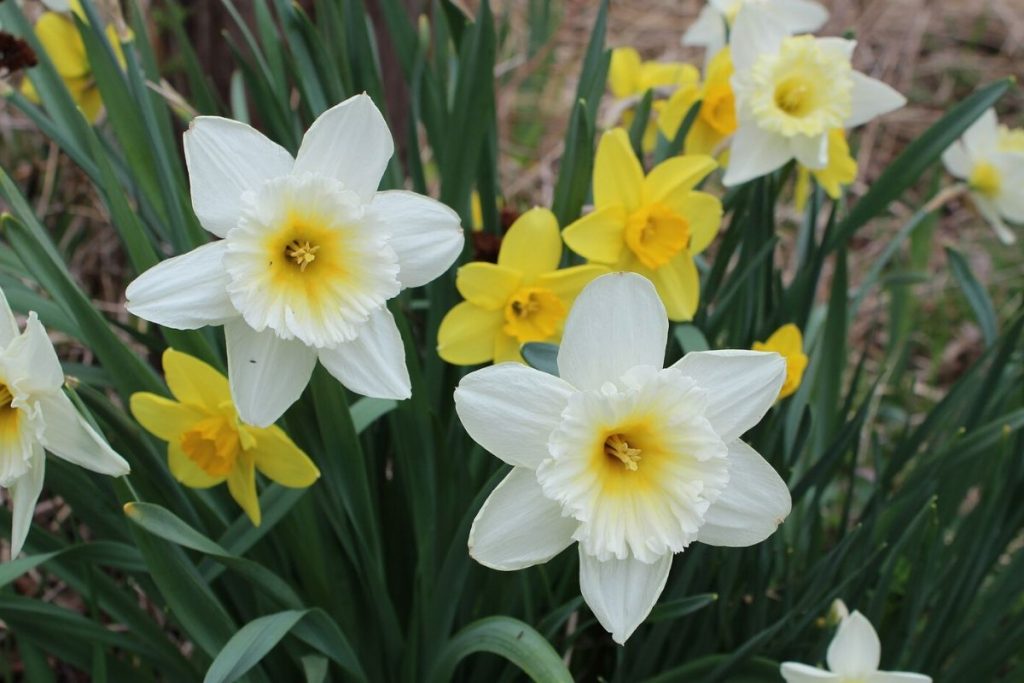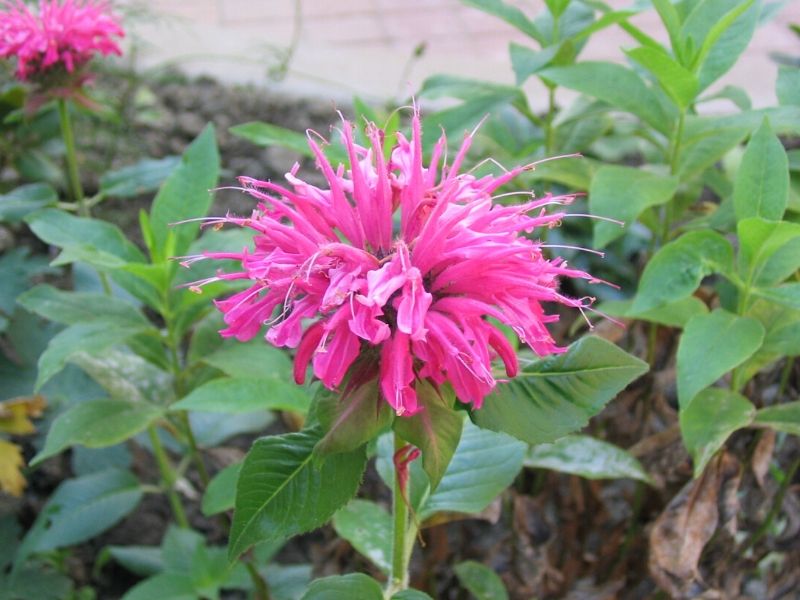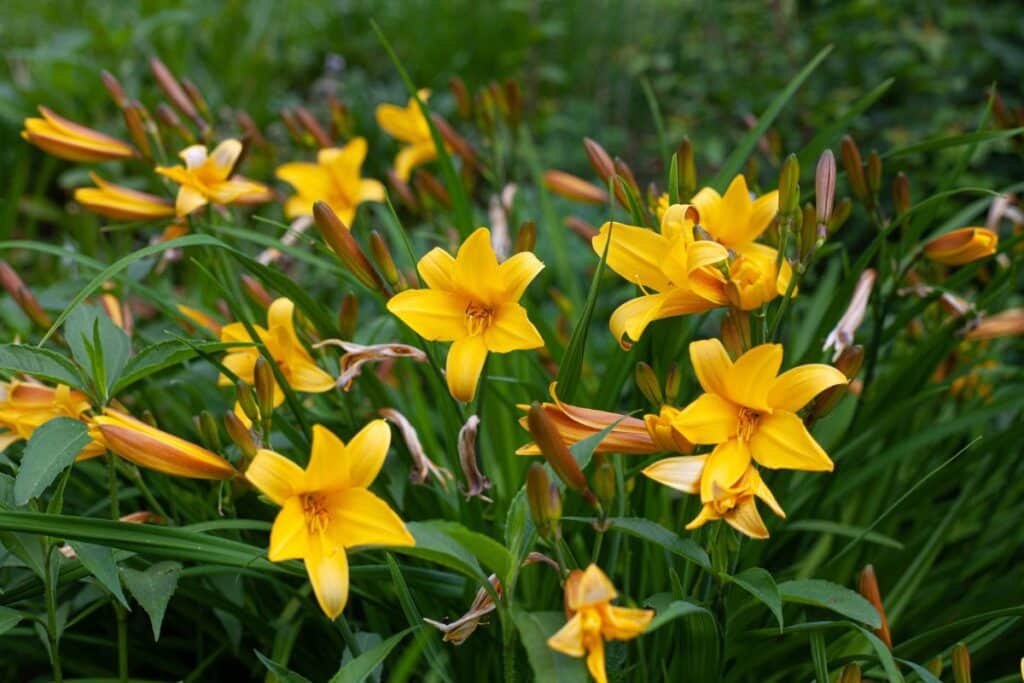Daylilies (Hemerocallis) are a favorite for many gardeners because these perennials have many attractive features. They are non-toxic to pets and humans, there are a vast variety of different colors, flower shapes, and species available, and the foliage resembles ornamental grasses that offer aesthetic appeal when they are not in bloom.
One of the most exciting things about daylilies is that they are not true lilies. Instead, these ornamental plants are members of an entirely different scientific family because, unlike average lilies, these florals have grass-like leaves. Daylilies are also edible while lily plants are toxic.
It is good to pair daylily plants with other types of foliage or flowers. The right combination of plants can protect your beautiful flowers or can enhance the overall look of your garden.
Quick Facts about Daylily Flower
Botanical name – Hemerocallis
Height – 8 inches to 5 feet (20 to 150 centimeters)
Colors – A great variety of flower colors with spiky vivid green foliage
Bloom Season – Mid-summer (short bloom time of 5 weeks) but some have multiple bloom seasons
Pairing Benefits – Enhance garden aesthetics, ideal for edible gardens, weed control
Let’s look at some of the best showstoppers to add when planting daylilies.
What to Plant with Daylilies
The most important thing you should remember when choosing the right companion plants is growing needs. It is best to pair daylily flowers with plants that have the same growing requirements because this will help reduce maintenance.
The Daylily is an extremely drought-tolerant plant that needs a minimum of five hours of full sun per day. Some darker varieties can grow well in dappled shade but most require lots of sun. These florals can be grown in any type of soil as long as it is a well-drained soil type.
Because these plants are so adaptable, you can pair them with just about any type of sun-loving drought-tolerant plant.
Here is a quick look at some of the best companion plants to pair with your daylilies.
Vegetable Gardens
Daylilies are often used in vegetable gardens because this edible plant is an ideal border plant to separate different types of veggies or to enhance the overall appeal of your vegetable garden.
You can pair daylilies with just about any type of vegetable plant including cabbages, carrots, squash, cucumbers, tomatoes, and just about any type of leafy green. The daylilies will attract plenty of pollinators to your garden during the blooming season and they will provide good weed control.
This is a perfect companion plant for food gardens because every part of the daylily is edible. Young shoots and flowers can be used to perk up salads or other cold dishes while the tubers can be boiled like potatoes. These florals are not nutrient-hungry and won’t deprive your vegetables of needed nourishment.
When you grow daylilies with vegetables, you should keep the variety in mind. Some taller varieties could deprive your vegetables of needed sunlight and should be positioned at the back or in a separate row. Shorter varieties can be co-planted in the same garden bed to keep weeds out of your garden.
Pairing Benefits – Enhance garden aesthetics, increase produce, weed control
Daffodils

- Botanical name – Narcissus
- Height – 12 – 16 Inches tall (30 – 41 cm)
- Colors – White, pink, orange, and combination colors as well as a scientifically created blue daffodil
- Bloom Season – Early spring to late winter
- Pairing Benefits – Enhance aesthetics, act as a weeding tool
Daffodils (Narcissus) are ideal landscape plants to add to your garden if you want to add lots of color during springtime while your daylilies might not have flowered yet. They are good companion plants for daylilies because the foliage of the daylilies will conceal the daffodil foliage when they start to die back after the bloom season.
Daffodils grow from bulbs and will produce lots of straight and narrow leaves that can add a little texture to your garden. The blooms will start to appear during late spring and early summer and will add lots of charm during this time.
When you plant daffodils, it is best to establish them between your daylilies or at the back of your garden bed. This way you can easily hide away the foliage when it starts to die back while the flowers will attract lots of attention during summer.
Daffodils are not too fond of full sun. They prefer light or light shade but should grow very well if established behind your daylilies in well-drained soil.
Russian Sage
- Botanical name – Perovskia atriplicifolia or Artemisia Iudoviciana
- Height – 2 – 3 feet (60 – 90 centimeters)
- Colors – Light grey-green foliage
- Pairing Benefits – Enhance aesthetics, weed barrier, pest repellant, and filler plants for daylilies
Russian sage (Perovskia atriplicifolia) and especially white sage (Artemisia Iudoviciana) are excellent daylily companion plants because the gray-green foliage adds a little bit of contrast and texture to your garden bed. It is an excellent filler plant to help you cover some bare areas among your daylilies.
These perennials have a fast-growing rate, they can grow well in any type of well-draining soil, are drought tolerant, and flourish in direct sunlight. With them in the garden, you can quickly create a very lush and aromatic garden. The small yellow-gray flower buds of this herb won’t draw away attention from the other flowers in your garden bed.
To grow sage with daylilies, you should establish this striking foliage between your daylilies because sage has a similar growing height to most daylily varieties. Just remember to leave plenty of room because sage will spread out quickly and can take up a lot of room in your garden bed.
See more: Russian sage companion plants
Bee Balm

- Botanical name – Monarda
- Height – 15 to 20 inches (38 to 50 centimeters)
- Colors – Scarlet flowers and green foliage
- Bloom Season – Autumn or Spring
- Pairing Benefits – Attract pollinators, enhance aesthetics, filler plant, and good border plants for daylilies
Bee balm (Monarda), also known as bergamot, bee balm, horsemint, and oswego tea are excellent pairing plants to include in your daylily bed because they develop impressive and distinct flowers that can add lots of color to your garden. The strange flowers of bergamot can look very charming in front of the long grassy leaf blades of daylilies.
Bergamot is an edible herb and a member of the mint family with many medicinal uses. The herb is nice and fragrant and will attract plenty of pollinators to your garden.
Horsemint grows very well in front of daylilies because they have the same growing requirements. These herbs need a minimum of 6 hours full sun per day, they thrive in well-draining soil and they are quite drought tolerant.
Because they are relatively short, you can grow bee balm as a border plant in front of daylilies. Dwarf varieties will only grow up to 15 inches tall while normal cultivars can grow up to 20 inches tall.
See more: Monarda companion plants
Coral Bells
- Botanical name – Heuchera
- Height – 6 to 16 inches (15 to 40 centimeters)
- Colors – Green, rose, purple and gold leaves
- Bloom Season – Spring to Summer
- Pairing Benefits – Filler plant, aesthetic appeal, contrast and texture, ground cover
Coral Bells (Heuchera) are superb foliage plants for daylilies if you want to add some color to your garden bed. The leaves of this bushy plant have vibrant colors with shades of green, rose, purple, and gold. This filler plant can act as a ground cover to keep the soil moist and is helpful for keeping weeds from sprouting in your garden.
Coral bells can grow well between your daylilies because they benefit from the shade provided by the tall spiky leaves of the daylily plants. When these bushy plants bloom, they will produce lots of delicate bell-shaped flowers that can also look charming.
The foliage will grow very in well-draining soil but might need a little bit more than your daylilies.
It is best to grow coral bells in front of daylilies but you can also establish them between these flowering plants.
See more: Companion plants for Heuchera
Shasta Daisy
- Botanical name – Leucanthemum x superbum
- Height – 3 to 4 feet (91 to 121 centimeters)
- Colors – White flowers and dark green leaves
- Bloom Season – Early or mid-summer
- Pairing Benefits – Aesthetica appeal, attract pollinators, garden filler
Shasta daisies (Leucanthemum x superbum) can also be good companion plants for daylilies if you want to add more color to your garden while your daylilies are in bloom.
These daisies bloom excessively when they are established in a sunny spot. They will produce hoards of beautiful white flowers with yellow centers. The herbaceous plant is quite hardy and can grow well in most soil types.
For optimal results, it is best to include these flowers between your daylilies. Daisies have a similar height and the striking white flowers will look brilliant with the cheerful daylily flowers peeking out amongst them.
Butterfly Bush
- Botanical name – Buddleia
- Height – 10 feet tall
- Colors – Purple, pink, white, yellow
- Bloom Season – Summer
- Pairing Benefits – Can repel mammalian pests
Butterfly bush, also known as Buddleia, is a shrub that blooms throughout the summer and attracts butterflies, hummingbirds, and bees.
Planting butterfly bush with your daylilies will create a lively garden with a beautiful mixture of colors and delightful visitors.
Butterfly bush can also discourage deer and rabbits from eating your plants. This makes it a great companion plant, particularly if you live in an area where these animals are present.
Balloon Flowers
- Botanical name – Platycodon grandiflorus
- Height – 2 feet tall
- Colors – Pink, blue, white
- Bloom Season – Summer to early fall
- Pairing Benefits – Thrive in similar conditions, contrast shape and color
Balloon flowers, also known as , have unique balloon-shaped buds that gradually open into beautiful blue, pink, or white flowers.
When planted with daylilies, they create a lovely contrast in shape and color.
The rounded shape of the balloon flowers and the lily shape of the daylilies work together to create a beautiful blend of textures. Also, both plants thrive in full sun or partial shade. Thus, the balloon flowers make excellent companion plants for daylilies.
Shrub Roses
- Botanical name – Rosa
- Height – 4 feet tall
- Colors – Yellow, pink, red, etc
- Bloom Season – Spring to fall
- Pairing Benefits -Scented, provides fullness to garden beds
Unlike traditional roses, shrub roses are easy to maintain and disease-resistant.
The Knock Out Rose, for example, blooms from May to the first frost and has vibrant colors of pink, red, and yellow. It can grow up to 4 feet tall and can be pruned to be a small shrub or a large plant.
Planting shrub roses with daylilies will create a classic, elegant garden, full of vibrant colors and enticing scents. The lilies’ delicate blooms delicately complement the fuller, bushier greenhouse of the roses.
Black Eyed Susans
- Botanical name – Rudbeckia
- Height – 3 feet tall
- Colors – Orange and black
- Bloom Season – Late summer and early fall
- Pairing Benefits -Perennials, good for pollinators
Black-eyed susans, of the genus Rudbeckia, are showy, daisy-like flowers that have dark centers that resemble an eye.
Planting black-eyed susans with daylilies will create a dramatic, eye-catching garden. The contrasting colors and shapes between the lilies and the susans provide an exhilarating display.
Black-eyed susans are renowned for attracting bees and birds to your garden. The sweet sound of fluttering from these creatures only serves to make the garden even more magical.
What NOT to Plant with Daylilies
Daylilies can be grown beside and amongst a huge variety of plants but there are some growths that don’t fare well when paired with these flowers. This is mostly because some plants cannot handle drought, heat, and direct sun. Here is a quick look at some plants that should be kept away from daylilies.
Ferns
Just about all fern plant species will quickly wilt and die if you add them to a daylily garden bed. Ferns don’t like too much sun and the leaves will quickly scorch if they are exposed to more than 2 hours of direct sunlight. Most species also require moist soil and high humidity. If the root systems become too dry, they will also die out.
Lily of the Valley
You would think that lily of the valley can be a good option because they grow quickly but they are not good companions at all. These Lily plants also require lots of water and they prefer shade. They will quickly die out if you establish them in the direct sun.
Hydrangeas
If you have an idea to grow hydrangeas as a backdrop with some daylilies in the front for texture or to form a border then you should reconsider. Hydrangeas only want a little bit of morning sun and they need moist soil to survive. This gorgeous plant is not a suitable candidate for your daylily bed.
Final Thoughts on the Best Companions for Daylilies
Daylilies can be paired with all sorts of hardy plants like daffodils, Russian sage, Bee balm, coral bells, Shasta daisies, as well as a couple of others we haven’t mentioned in our article like baby’s breath, false indigo, blazing star, rudbeckia hirta, and many others.
They can also be paired with other companion plants like vegetables. Growing daylilies has never been easier!
No matter what kind of dayliles you’re growing, from Stella D’Oro lilies to orange daylilies or even those with purple flowers, these spring bulbs can be planted alongside all kinds of other flowering plants – and make great companions for them, too.
We hope that our guide of landscaping ideas with daylilies made it easier for you to decide on the right type of daylily companion plants to add to your garden. And if you are looking for some companions for other plants in your garden then you should have a look at some of our other guides where you can find the best plant growing and care tips.
See more: Day lily flower meaning
References
*image by wirestock_creators/depositphotos







